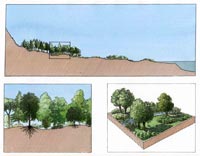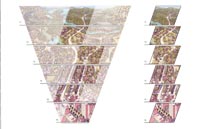- Home
- About CATS
- The Transect
- Transect Codes Council
- Resources & Links
- Contact CATS
- CATS Programs
- Research
- Publications
- Education
- AWARDS
- CATS TOOLS
- Codes
- Modules
- Images
All images are available for free download for use in PowerPoint (low resolution) or print (high resolution), with credit as noted.
 |
Quadrat & Dissect in Nature The environmental assessment of a site requires the identification of typical eco-zones (or habitats) by means of a Synoptic Survey, which has two analytical protocols, the Dissect and the Quadrat. A natural transect is shown at the top. The Dissect (left) is a sectional cut that includes what is on the surface of the ground, above the ground (including the microclimate) and what is underground (the humidity and water table). For the Quadrat (right), a normative area is delineated within which all the flora and fauna are quantified. From this sampling, the characteristics of other similar zones can be assumed. Duany Plater-Zyberk & Company |
 |
Transect of the Built Environment The human habitat can be analyzed by a method similar to the environmental assessment. First a local transect, consisting of the most valued and desired zones, is identified by urban planners and local citizens. The model six-zone Rural-Urban Transect diagram and its SmartCode descriptions are intended to serve as the base comparison for local calibration. Duany Plater-Zyberk & Company |
|
 |
Quadrat & Dissect of the Built Environment The Synoptic Survey involves the equivalent of a Dissect, which in this case measures both the public and private realms, and the equivalent of a Quadrat, counting density and other components from a block of lots. This sampling of the local DNA generates a set of standards – a code - for each Transect Zone. Duany Plater-Zyberk & Company |